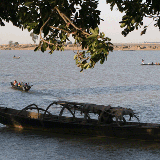Major Tourist Attractions: Great Mosque of Djenne, Festival au Desert, Djinguereber Mosque, Djenne-Djenno

Mali Travel Insurance
Arch RoamRight offers travel insurance for U.S. residents traveling to Mali. Whether you need travel insurance to help protect the expenses you’ve paid into your vacation, or short-term travel medical insurance while you’re in Mali, we have several travel insurance plans for you to choose from. Get started by completing our quote form above.
About Mali
Sandwiched between the Sahara Desert and coastal tropics, Mali has long been a popular destination for travelers to West Africa. From the Great Mosque of Djenne – the largest mud brick building in the world – to the sandy streets of fabled Timbuktu, visitors
to Mali are spoiled for choice when it comes to historical and cultural attractions.
Mali is one of many Francophone countries in West Africa. In addition to French, there are a variety of local languages that are spoken, and a number of people can communicate with basic English. The major tourist attractions in Mali are easily accessible,
but it's recommended that you hire a local guide. Many travelers get around by bus or private car, but if you're feeling adventurous, you can take a relaxed trip down the Niger River in a traditional pinasse, a riverboat carved out of the trunk of
a large tree.
A typical itinerary starts with a few days in Bamako, Mali's bustling capital. Visit the Grand Marche, the country's largest market, and look out for the artisan crafts for which Mali is known. Shimmering bazin fabric, handmade musical instruments, and
a wide range of carvings and jewelery can all be purchased at affordable prices. Don't forget to haggle! Cap off your time in Bamako with a concert – Malian musicians are world renowned – and a visit to the National Park, a sprawling oasis in the
middle of the city.
After Bamako, head north to Segou and Djenne, where you can get a feel for the ancient Mande empires that ruled over the Sahel. Nearby Dogon Country should not be missed. Here, the Dogon ethnic group live in a patchwork of farms and villages that back
up to staggering cliffs. The architecture, history and cultural practices are all worth discovering.
Heading further north depends on the current security climate. While fighting in the north of the country has ended, it's important to check with your embassy for the latest information before making a decision on your travel plans.
Accommodation in Mali ranges from budget hotels and guesthouses to luxury 5-star properties. While it is a developing country, Mali does have something of a tourist infrastructure, with a registry of certified local guides and clear efforts to preserve
major cultural and historical sites.
Here are a few can't-miss highlights that you should pencil into your trip agenda:
- Visit Djenne's Grand Mosque, the world's largest mud brick building
- Drink a chilled bissap, an iced, sweetened hibiscus tea, on the streets of Bamako
- Hike from village to village and discover the cliffside dwellings in Dogon Country
- Take a pinasse ride to villages around Segou
- Enjoy a river side meal of barbecued fish in Mopti, the “Venice of Mali”
- Swim at the base of the towering Siby waterfall
- Learn about the history of animism in the village of Kita
- Listen to a local musician play the kora in Bamako
- Eat rice and tigadigana, a spicy peanut based sauce, from a roadside eatery
- Walk through the sandy streets of Timbuktu
- Take the train from Bamako to Kayes and discover the beautiful scenery of Mali's northwest region
- Take a local drumming and/or dance class
Embassy Contact
Address: Rue 243 Porte 297, Mali
Phone: 223 20 70 23 00